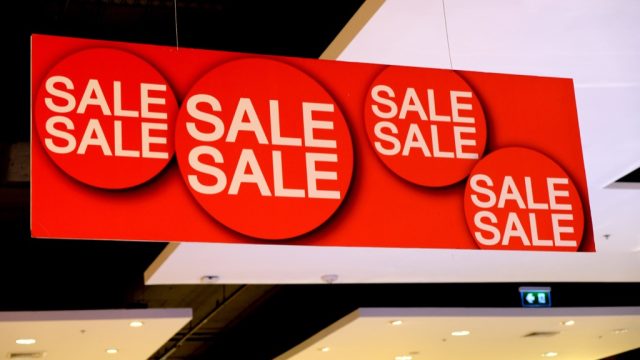Genius Tips for Recognizing That a “Sale” Is Actually a Ripoff

Fact: No two sales are created equal. And while some massive markdowns really are going to get you the best bang for your buck, other supposed blowouts are just bad bargains disguised as good deals.
So how are you supposed to tell the two apart? Well, with the help of Sara Skirboll, a shopping and trends expert at the great shopping site Retail Me Not, we’ve compiled some of the major red flags that the “deal” in front of you isn’t much of a deal. And if what follows isn’t enough shopping advice for you, don’t miss these 33 Tiny Shopping Habits That Will Save You Loads of Money in the Long Run.
1. Be wary of sales that are seemingly always taking place.
Sometimes, your favorite store advertises a blowout sale that seems too good to be true. And then the next weekend they advertise it again. And again. That’s a sign that sale isn’t so special after all, and is simply a strategy designed to get you to overspend. One study by the non-profit Center for the Study of Services, also known as Consumers’ Checkbook, found that many popular stores have perpetual sales on certain items, so much so that the “sale” price is essentially the regular price.
Consumers’ Checkbook found this happened most frequently at JC Penney, Kmart, Kohl’s, Macy’s, Neiman Marcus, and Sears. To conduct their research, Checkbook tracked the prices of 20 big-ticket items at 17 retailers over the course of 10 months. They found that 15 of the 17 retailers marked their items “on sale” 57 percent of the time, “meaning that more often than not they promoted prices as discounts that weren’t really special prices,” the group wrote. What’s more, Checkbook found that most of the “sale” items could also be purchased at lower prices elsewhere.
2. Avoid sales advertised by big, flashy signs.
Haven’t gone to the mall in a while and can’t tell which stores’ sales are of the perpetual variety? The size and the content of the signs advertising the sale can help clue you in. “Despite what the giant ‘blowout’ signs may lead you to believe, there are typically sales on just a few items or categories in the store, such as just appliances or just bedding,” Skirboll explains. “Big signs are more of a red herring meant to get you in the store to buy non-sale items.”
Checkbook also notes that common phrases to watch out for include the flashy ones that practically scream for your attention, such as “‘SALE! 60% OFF!’ or ‘This weekend only: Save an extra 40%!’ or ‘[Insert your favorite holiday] Special Savings!’ or ‘Regular price: $299, our price: $199.'”
3. Don’t be fooled by bundled sales.
Those “10 for $10” sales seem like a good deal—until you realize that they’re actually just making you buy more than you would have otherwise (and, in the worst case, items you wouldn’t have otherwise). Skirboll advises staying away from stores advertising these “buy more to save more” deals, as they “make you want to buy more to get a good deal.”
For instance, let’s say you’re shopping at Target and you come across a selection of socks that are “$10 for five pairs.” Seems like a pretty decent bargain, right? But hold on a second. You only really need one pair of socks, and there’s another pair on a rack nearby being sold for just $3. Per pair, that five for $10 deal might be cheaper, but if you really only need a single pair of peds, then it makes more economic sense to buy the $3 pair instead.
3. Those “free gifts” probably aren’t worth it.
How many times have you actually used the free gifts given to you during a special in-store promotion—you know, things like a complimentary pouch or tiny perfume samples? Most of the time, the gifts included in these promos are useless do-dads like totes and teddy bears, and all they really do is deceive you into spending more money just to meet a minimum.
Say you go to Bloomingdales to pick up some renewal serum from Clinique. But wait! If you spend just a little bit more, you qualify for deluxe samples of the brand’s Rinse-Off Foaming Cleanser and Dramatically Different Moisturizing Gel, and so you decide to throw in a lipstick that you don’t actually need. In the moment, it might feel like you’re spending more to save more, but all that’s really happening is you’re being deceived into buying things you don’t need in order to get gifted things you also don’t need.
4. If the free shipping minimum is too high, then say goodbye.
“If the shipping is free only if you spend a certain amount—like $30 or $50—stay away,” says Skirboll. “Chances are you’ll end up trying to find items to get the deal and spend a lot more to save a few bucks.”
Retailers guilty of this include Macy’s, where free shipping starts at $99; Bloomingdale’s, where the free shipping minimum is $150; and ASOS, where shipping is only free if you spend $50 or more.
5. Don’t be deceived by doorbuster deals.
“Doorbuster” sales, defined as deals only offered in store that are available for a limited time, are great—especially during spectacular sale days like Black Friday. However, Skirboll warns that the items included in doorbuster deals are often “off-brand or lower quality items.”
“Like big flashy signs,” she says, “doorbuster sales are meant to get you in the door so once you start shopping around, you forget you actually came in for a sale.”
To discover more amazing secrets about living your best life, click here to follow us on Instagram!